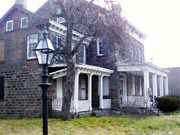Renewed efforts to restore the Apple Tree House for public viewing have blossomed in recent weeks, as Mayor Glenn D. Cunningham, a history buff, has signed the papers necessary to complete the application for the State and National Register of Historical Places.
After driving by the 261-year-old house on Academy Street, Cunningham realized how badly negligence had caused the structure’s deterioration. Preservation advocates, who had been trying to secure the landmark status for the two-and-one-half story structure for several years, came into contact with Cunningham and arranged a meeting on Feb. 15 to discuss what measures needed to be taken to protect it.
“As a historian, I recognize the urgency in securing the Apple Tree House as both a state and national landmark,” Cunningham said. “This application will be expedited and those goals will be achieved.”
John Gomez of the Jersey City Landmarks Conservancy, a non-profit organization geared toward historic preservation, also attended the meeting and will serve in an advisory capacity for the restoration project as it progresses.
For the past several years, a group has placed a wreath at the house on President’s Day to recognize the site where George Washington met with Marquis de Lafayette to discuss combat strategy during the Revolutionary War. Guy Catrillo, former chairman of the Jersey City Historic Preservation Commission, is part of this group and said he is elated that Cunningham has taken a pro-active role in restoring the house.
Former Mayor Bret Schundler also took this initiative, but failed to follow through, Catrillo said. A few weeks ago, Catrillo was given an envelope that contained the Apple Tree House application for the state and national landmark registry. It had never been signed and sent out, though, and remained sitting in a drawer in City Hall until someone came across the envelope with Catrillo’s name.
“Bret may have been my friend, my buddy,” Catrillo said, “but I got very disappointed with him in some matters.” The application, mostly completed, just needed to be signed by Schundler and sent to the state, which is eager to grant the Apple Tree House the landmark status that opens the doors for many state and federal grants for restorative projects. According to Catrillo, the state historic preservation office has said that the property is one of the state’s “most historical assets.”
A long history
Named for the apple orchards that once bloomed in front of the house, the one-acre property is rich in American historical significance. Originally known as The Van Wagenen Homestead, the site dates back to 1658. Located at the intersection of Bergen Avenue and Academy Street, it is one of the earliest settlements of the village of Bergen, which later became Jersey City.
During the American Revolution, a descendent of the Van Wagenen family occupied the house as it stands today and maintained an a farm and apple orchard. The home is separated into two distinct structures. One one side, there is a two-story sandstone laid ashlar structure that was first built in 1740. The rectangular Federal-style structure achieved its legendary status when it served as a home and a headquarters for Marquis de Lafayette.
Next to that stands a two-and-one-half story structure that dates back to 1820 that is designed in the Greek Revival style popular in the 19th century.
From 1653 to 1947, the property was owned by the Van Wagenen family. It was then sold to the Quinn family, who turned it into a funeral home. In the 1990s, Provident Bank acquired the property and information surfaced that the company intended to demolish the building to make room for executive parking and an ATM machine. After a public outcry, Provident agreed to sell the property to Jersey City, at which point the historical preservation efforts began.
Cunningham would like to see the restored building turn into a public museum that models the type of educational atmosphere found at Waterloo Village where people dressed in colonial garb demonstrate how our ancestors conducted their lives by demonstrating knitting, churning butter, and other skills embodied in the colonial era.
